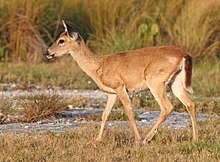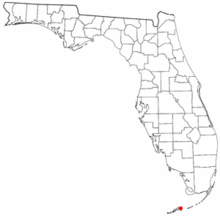Florida Key Deer
| Key deer | |
|---|---|
 |
|
| A female on Big Pine Key | |
| Scientific classification | |
| Kingdom: | Animalia |
| Phylum: | Chordata |
| Clade: | Synapsida |
| Class: | Mammalia |
| Order: | Artiodactyla |
| Family: | Cervidae |
| Subfamily: | Capreolinae |
| Genus: | Odocoileus |
| Species: | O. virginianus |
| Subspecies: | O. v. clavium |
| Trinomial name | |
|
Odocoileus virginianus clavium Barbour & G. M. Allen, 1922 |
|
 |
|
| Key Deer range | |
The Key deer (Odocoileus virginianus clavium) is an endangered deer that lives only in the Florida Keys. It is a subspecies of the white-tailed deer (O. virginianus). It is the smallest North American deer.
This deer can be recognized by its characteristic size, smaller than all other white-tailed deer. Adult males (known as bucks) usually weigh 25–34 kg (55–75 lb) and stand about 76 cm (30 in) tall at the shoulder. Adult females (does) usually weigh between 20 and 29 kg (44 and 64 lb) and have an average height of 66 cm (26 in) at the shoulders. The deer is a reddish-brown to grey-brown in color. Antlers are grown by males and shed between February and March and regrown by June. When the antlers are growing, they have a white velvet coating. The species otherwise generally resembles other white-tailed deer in appearance.
Key deer easily swim between islands.
Living close to humans, the Key deer has little of the natural fear of man shown by most of their larger mainland relatives. The deer are often found in residents' yards and along roadsides where plants and flowers grow. This often results in car-to-deer collisions, as the deer are more active (and harder to avoid) at night. It is not unusual to see them at dusk and dawn.
Breeding occurs all year, but peaks in October and December. Territorial activity is limited to defending a receptive doe from other bucks. Longevity records are 9 years for males and 7 years for females. Adult females form loose matriarchal groups with one or two generations of offspring, while bucks feed and bed together only during the nonbreeding season.
The range of the Key deer originally encompassed all of the lower Florida Keys (where standing water pools exist), but is now limited to a stretch of the Florida Keys from about Sugarloaf Key to Bahia Honda Key. Key deer use all islands during the wet season when drinking water is more generally available, retreating to islands with a perennial supply of fresh water in dry months.
Key deer inhabit nearly all habitats within their range, including pine rocklands, hardwood hammocks, mangroves, and freshwater wetlands. The species feed on over 150 types of plants, but mangroves (red, white, and black) and thatch palm berries make up the most important part of their diets. Pine rockland habitat is important, as well, because it is often the only reliable source of fresh drinking water (Key deer can tolerate drinking only mildly brackish water). Habitat destruction due to human encroachment cause many deer to feed on non-native ornamental plants.
...
Wikipedia

